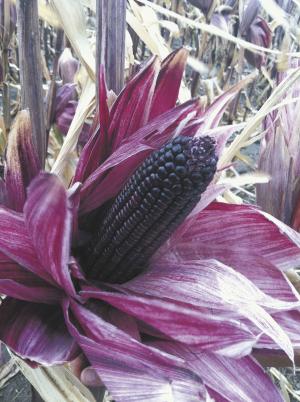2013 - Volume #37, Issue #1, Page #06
[ Sample Stories From This Issue | List of All Stories In This Issue | Print this story
| Read this issue]
Purple Corn Taps Into Hot Markets
 |
“All foods that are red, purple or black contain antioxidants,” explains Lee French, who has been doing research on ancient corn varieties for almost 20 years. French was intrigued by the purple corn varieties and realized it provided an opportunity to create a natural dye.
“It is an alternative to synthetic Red Dye 40 that’s produced from petroleum products,” French says, noting that the dye hasn’t been proven to cause cancer, but chemicals used to create the dye can.
Not only has Suntava Purple Corn proven to be a good source of natural dye, the nutrition exceeds other corn varieties.
“The biggest thing is that purple corn is so unique because of its high antioxidant properties (higher than blueberries),” says Bill Petrich, CEO of Suntava. “It’s packed with powerful nutritional capabilities. Bakers and gluten-free people are interested in it for its nutrition, and it adds color to the end product – such as purple cornmeal.”
The corn is ideal for three markets. First, it’s a natural red dye for foods, cosmetics and other markets. Second, as a grain, it’s perfect for cereals, snacks and all sorts of foods, such as purple tortilla chips, cornmeal and masa flour. Finally, it’s a new option for the nutraceutical (fortified food and dietary supplement market) to add nutritional health benefits.
The purple corn is non-GMO, which also appeals to consumers. It requires similar growing practices as field corn, along with standards to maintain the quality and integrity of Suntava Purple Corn.
Suntava continues to research new markets for the purple corn, which is already in purple tortilla chips, cereals and other products. French points out that corn has one big advantage in the dye market.
“We can store our grain and don’t have to extract the dye right away unlike other crops such as berries and beets,” he explains.
Purple corn research is young compared to the hundred years of yellow corn research, French adds. But so far it’s promising, and continued work will improve the variety even more.
Farmers in the region interested in growing purple corn in the future may contact Suntava for more information.
Contact: FARM SHOW Followup, Suntava, LLC, P.O. Box 268, Afton, Minn. 55001 (ph 651-998-0723; www.suntava.com).

Click here to download page story appeared in.

Click here to read entire issue
To read the rest of this story, download this issue below or click here to register with your account number.




